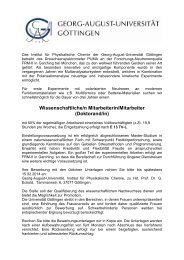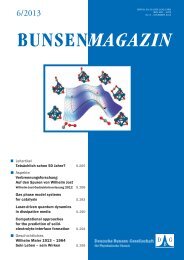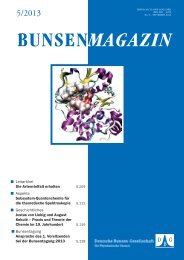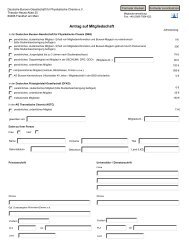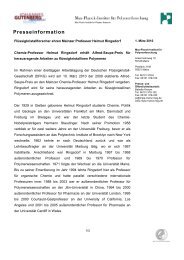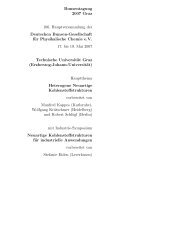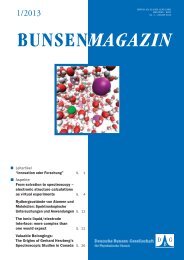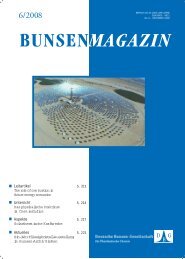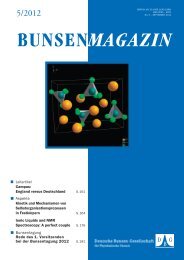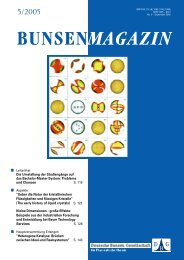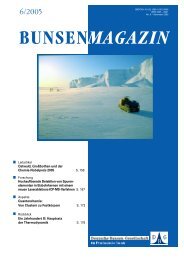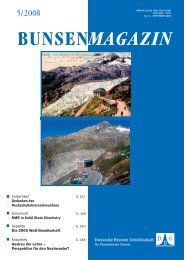BuMa_2010_04 - Deutsche Bunsengesellschaft für Physikalische ...
BuMa_2010_04 - Deutsche Bunsengesellschaft für Physikalische ...
BuMa_2010_04 - Deutsche Bunsengesellschaft für Physikalische ...
Sie wollen auch ein ePaper? Erhöhen Sie die Reichweite Ihrer Titel.
YUMPU macht aus Druck-PDFs automatisch weboptimierte ePaper, die Google liebt.
DEUTSCHE BUNSEN-GESELLSCHAFT<br />
structures at the atomic level but the two techniques are really<br />
almost complementary. Scanning probe microscopy allows fast<br />
data acquisition and interpretation and the study of individual<br />
features, regardless of the degree of order, but it cannot deliver<br />
direct structural information about the three-dimensional arrangement<br />
of atoms at the pm level, in particular not for atoms<br />
below the outer-most surface layer. LEED can deliver precise<br />
crystallographic data but is restricted to relatively well-ordered<br />
surface structures. The results always refl ect the properties<br />
of a large ensemble of surface unit cells. Photoelectron diffraction<br />
(PhD) [Wood07] and surface X-ray diffraction (SXRD)<br />
[Feid89] are related surface sensitive electron and X-ray diffraction<br />
methods, which deliver crystallographic information at<br />
a similar level of accuracy. PhD is element specifi c and does<br />
not require long-range order; SXRD also works under high-pressure<br />
conditions where electrons cannot be used. These methods,<br />
however, require synchrotron radiation and are therefore<br />
not as readily available as LEED systems, which are part of the<br />
standard equipment of most surface science laboratories.<br />
In the previous sections we have highlighted only a small fraction<br />
of the research that can be carried out by LEED with an<br />
emphasis on simplicity in order to explain the basics of the<br />
technique. A number of recent innovations have opened up the<br />
technique to a variety of technically important surface and interface<br />
systems with relevance to biology and nano-electronics.<br />
Much of recent developments in LEED-IV structure determination<br />
were directed towards improving the model calculations<br />
involved in the data analysis. This includes approximations<br />
that replace parts of the full quantum mechanical scattering<br />
calculations and thus speed up the optimization process<br />
(e.g. “Tensor LEED” [Rous93], “molecular T matrix approach”<br />
[Blan05]), “direct methods” aiming at a direct conversion of<br />
IV curves into a three-dimensional structure [Seub00], and<br />
better mathematical descriptions of scattering potentials and<br />
thermal vibrations of semiconductors and organic molecules.<br />
To date, computer power is only a limiting factor for very large<br />
unit cells with many (> 20) geometrical parameters to be optimized.<br />
The determination of a medium size structure can be<br />
performed on a modern personal computer within a matter of<br />
hours or a few days. Often the lack of enough experimental<br />
data for comparison with model calculations is a more severe<br />
limitation for the analysis of more complex surface structures<br />
with large unit cells. This limitation can be overcome by recording<br />
IV curves at different angles of incidence, each creating<br />
an additional set of data [Held95]. The sum of these improvements<br />
enables the accurate characterization of structures at<br />
the interfaces between inorganic substrates and large organic<br />
molecules as they are found in biological interfaces or organic<br />
electronic devices, and thus open exciting new applications for<br />
surface and interface crystallography by LEED.<br />
Another exciting perspective is offered by the low-energy electron<br />
microscope (LEEM), a combination of imaging electron<br />
microscope and LEED. This microscopic technique has been<br />
developed by Bauer and Telieps already in the 1960’s and 70’s<br />
[Baue94,Baue98] but has become widely available only in the<br />
last decade or so. The combination of imaging and diffraction<br />
allows characterizing surface areas of the size of μm to nm.<br />
UNTERRICHT<br />
One application, often referred to as “micro-LEED”, is the collection<br />
of LEED-IV data from an area of a few μm in diameter<br />
or less. This way, surface structures of single domains on single<br />
crystal surfaces [Figu06], artifi cial nanostructures of semiconductor<br />
devices, or crystallites of polycrystalline material<br />
[Corn10] can be determined, which enables surface structure<br />
determination for completely new classes of materials with a<br />
wide range of applications.<br />
REFERENCES<br />
[Baue94] E. Bauer, Rep. Prog. Phys. 57 (1994) 895.<br />
[Baue98] E. Bauer, Surf. Rev. Lett. 5 (1998) 1275.<br />
[Blan05] M. Blanco-Rey, P. de Andres, G. Held, D.A. King, Surf. Sci. 579<br />
(2005) 89 .<br />
[Brau05a] W. Braun, H.-P. Steinrück, G. Held, Surf. Sci. 575 (2005) 343.<br />
[Brau05b] W. Braun, G. Held, Surf. Sci. 594 (2005) 203.<br />
[Clar85] L. J. Clarke , „Surface Crystallography - An Introduction to Low<br />
Energy Electron Diffraction“, Wiley, Chichester, 1985.<br />
[Corn10] A. Cornish, T. Eralp, A. Shavorskiy, R. A. Bennett, G. Held, S. A.<br />
Cavill, A. Potenza, H. Marchetto, S. S. Dhesi, Phys. Rev. B 81,<br />
(<strong>2010</strong>) 085403.<br />
[Davi27] C. Davisson, L. H. Germer, Phys. Rev. 30 (1927), 705.<br />
[Feid89] R. Feidenhans’l, Surf. Sci. Rep. 10 (1989) 105-188.<br />
[Ferr<strong>04</strong>] N. Ferralis, K. Pussi, E. J. Cox, M. Gierer, J. Ledieu, I. R. Fisher,<br />
C. J. Jenks, M. Lindroos, R. McGrath, and R. D. Diehl, Phys.<br />
Rev. B 69 (20<strong>04</strong>) 1534<strong>04</strong>.<br />
[Figu06] J. de la Figuera, J.M. Puerta, J.I. Cerda, F. El Gabaly, K.F.<br />
McCarty, Surf. Sci. 600 (2006) L105.<br />
[Hein91] K. Heinz, U. Starke, F. Bothe, Surf. Sci. Lett. 243 (1991) L70.<br />
[Hein92] K. Heinz, U. Starke, M. A. Van Hove, G. A. Somorjai, Surf. Sci.<br />
261 (1992) 57.<br />
[Hein94] K. Heinz, Surf. Sci. 299/300 (1994) 433.<br />
[Hein99] K. Heinz, S. Müller, L. Hammer, J. Phys.: Condens. Matter 11<br />
(1999) 9437.<br />
[Held95] G. Held, A. Wander, and D. A. King, Phys. Rev. B 51 (1995)<br />
17856.<br />
[Held98] G. Held, J. Schuler, W. Sklarek, and H.-P. Steinrück, Surf. Sci.<br />
398 (1998) 154.<br />
[Held01] G. Held, W. Braun, H.-P. Steinrück, S. Yamagishi, S. J. Jenkins,<br />
and D. A. King, Phys. Rev. Lett. 87 (2001) 216102.<br />
[Henz77] M. Henzler in „Electron Spectroscopy for Surface Analysis“, Ed<br />
H. Ibach, Springer Berlin, 1977, 117.<br />
[Henz91] M. Henzler, W. Göpel, „Oberfl ächenphysik des Festkörpers“,<br />
Teubner, Stuttgart, 1991.<br />
[Li_09] H. I. Li, K. Pussi, K. J. Hanna, L.-L. Wang, D. D. Johnson,<br />
H.-P. Cheng, H. Shin, S. Curtarolo, W. Moritz, J. A. Smerdon,<br />
R. McGrath, and R. D. Diehl, Phys. Rev. Lett. 103 (2009)<br />
056101.<br />
[Mori10] W. Moritz, B. Wang, M.-L. Bocquet, T. Brugger, T. Greber,<br />
J. Wintterlin, and S. Günther, Phys. Rev. Lett. 1<strong>04</strong> (<strong>2010</strong>)<br />
136102.<br />
[Over98] H. Over, Prog. Surf. Sci. 58 (1998) 249.<br />
[Pend74] J. B. Pendry, „Low Energy Electron Diffraction“, Academic<br />
Press, London, 1974.<br />
[Pend80] J. B. Pendry, J. Phys. C 13 (1980) 937.<br />
[Poon<strong>04</strong>] H.C. Poon, M. Weinert, D.K. Saldin, D. Stacchiola, T. Zheng,<br />
W.T. Tysoe, Phys. Rev. B 69 (20<strong>04</strong>) 035401.<br />
[Rous93] P. J. Rous, Prog. Surf. Sci. 39 (1992) 3.<br />
[Seub00] A. Seubert, D. K. Saldin, J. Bernhardt, U. Starke K. Heinz, J.<br />
Phys. Condens. Matter 12 (2000) 5527.<br />
[SSD_02] P. R. Watson, M. A. Van Hove, K. Hermann NIST Surface Structure<br />
Database: Version 5.0 (2002).<br />
[Vanh79] M. A. Van Hove and S. Y. Tong, „Surface Crystallography by<br />
LEED“, Springer, Berlin, 1979.<br />
[Vanh86] M. A. Van Hove, W. H. Weinberg, C.-M. Chan „Low-Energy<br />
Electron Diffraction“, Springer, Berlin, 1986.<br />
[Woll98] J. Wollschläger, F. Schäfer, K.M. Schröder, Surf. Sci. 396<br />
(1998) 94.<br />
[Wood64] E. A. Wood, J. Appl. Phys. 35 (1964) 1306.<br />
[Wood07] D. P. Woodruff, Surf. Sci. Rep. 62 (2007) 1.<br />
131



